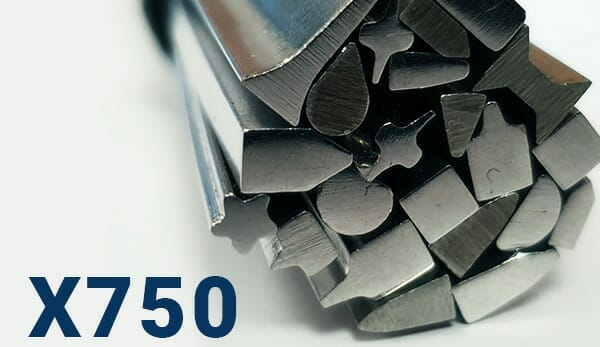
Often referred to as Inconel® Alloy X-750, this high-performance austenitic nickel-chromium alloy is made precipitation-hardenable by the addition of aluminum and titanium. It has good resistance to corrosion and oxidation along with high tensile and creep-rupture properties at high temperatures. For extended applications that require high strength at high temperatures, Alloy X-750 may require a solution treatment, with air cooling between intermediate and final aging.
Alloy X-750 displays excellent workability, including machinability and welding. Alloy X-750 has excellent relaxation resistance, good elevated temperature strength properties to 1300ºF (700°C), and oxidation resistance to 1800ºF (983˚C). Lastly, Alloy X-750 is resistant to a wide variety of industrial corrosives under both oxidizing and reducing conditions, while also displaying excellent resistance to chloride stress corrosion cracking in fully age-hardened conditions.
X-750 Composition
| C | Mn | Si | S | Cr | Ni | Cb (Nb) | Ti | Al | Fe | Co | Ta | Cu | |
|---|---|---|---|---|---|---|---|---|---|---|---|---|---|
| Min | 14.0 | 70.0 | 0.70 | 2.25 | 0.40 | 5.0 | |||||||
| Max | 0.08 | 1.00 | 0.50 | 0.01 | 17.0 | 1.20 | 2.75 | 1.00 | 9.0 | 1.0 | 0.05 | 0.50 |
Commercial use of the alloy is governed by industry standards such as: AMS 5698, AMS 5699, NACE MR0175 (ISO 15156‐3), NACE MR0103 (ISO 17945), ASTM B637, MIL‐DTL‐24493.
El uso aeroespacial se suministra a través de la norma AMS 5678G, que controla aún más el material con ensayos de cualificación adicionales sobre la microestructura del alambre trefilado final.
It has been reported that the SCC resistance of Inconel X-750 can be improved by direct aging in the precipitation regime of 704°C to 8710°C. Therefore, the microstructural changes that occur when Inconel X-750 is thermally treated between 7040°C and 8710°C for up to 200 hours following a 2-hour solution anneal at 10750°C, 11490°C, or 12040°C has been studied. The coarsening kinetics of the γ’ particle growth obeyed the time-law prediction of Lipshitz-Slazor-Wagner theory of diffusion controlled growth at all aging temperatures. The γ’ precipitate lost coherency by the nucleation of dislocation loops within the precipitate, the interaction of dislocation at the interface and attraction of matrix dislocations to the particle/matrix interface.
- Gas Turbines
- Thrust Reversers
- Wheels
- Ducts
- Discs
- Aircraft Structures
- Rocket Engines
- Nuclear Reactors
- Heat Treat Fixtures
- Cryogenic Vessels
- Cryogenic Springs
- Cryogenic Fasteners
- Exhaust Valves
- Industrial Pressure Vessels
- Herramientas
Póngase en contacto con un representante de ventas de CWI para obtener más información sobre esta aleación especial y cómo puede aplicarse a su sector.
Opciones de envasado
- Bobina
- Carretes
- Bares
- Embalaje personalizado disponible
